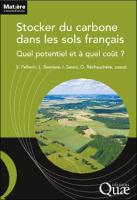Stocker du carbone dans les sols français
Quel potentiel et à quel coût?
| dc.contributor.editor | Pellerin, Sylvain | |
| dc.contributor.editor | Bamière, Laure | |
| dc.contributor.editor | Savini, Isabelle | |
| dc.contributor.editor | Réchauchère, Olivier | |
| dc.date.accessioned | 2021-12-02T16:25:52Z | |
| dc.date.available | 2021-12-02T16:25:52Z | |
| dc.date.issued | 2021 | |
| dc.identifier | ONIX_20211202_9782759231485_17 | |
| dc.identifier.uri | https://library.oapen.org/handle/20.500.12657/51619 | |
| dc.language | French | |
| dc.subject.classification | thema EDItEUR::R Earth Sciences, Geography, Environment, Planning::RB Earth sciences::RBG Geology, geomorphology and the lithosphere::RBGB Sedimentology and pedology | en_US |
| dc.subject.other | soil | |
| dc.subject.other | pollution | |
| dc.subject.other | decision support | |
| dc.subject.other | climate | |
| dc.subject.other | CO2 | |
| dc.subject.other | sustainable development | |
| dc.subject.other | modeling | |
| dc.title | Stocker du carbone dans les sols français | |
| dc.title.alternative | Quel potentiel et à quel coût? | |
| dc.type | book | |
| oapen.abstract.otherlanguage | The "4 per 1000: Soils for Food Security and Climate" initiative proposes to increase the stock of carbon in all soils around the world by four thousandths each year. At the request of Ademe and the Ministry of Agriculture and Food, INRA (now INRAE) conducted a study, focused on mainland France, aimed at estimating the potential for carbon storage. agricultural and forest soils and, ultimately, to measure the potential contribution of this lever to the objective of reducing net greenhouse gas emissions. Various candidate practices (intermediate crops, contribution of new organic resources, grassland management, agroforestry, etc.) were evaluated. The results obtained showed a high variability of the additional carbon storage. The study also made it possible to estimate the additional cost, for farmers, of implementing these storage practices, and then an allocation of the storage effort between the practices and the regions was made. These data will allow the various actors concerned to make the best choices for storing more carbon in the soil. This book is aimed at decision-makers responsible for developing public climate policies in the agricultural sector, territorial managers, planners, engineers and technicians, farmers and all citizens interested in the issue of agriculture. and climate change. | |
| oapen.identifier.doi | 10.35690/978-2-7592-3149-2 | |
| oapen.relation.isPublishedBy | f3266e68-be04-43a2-896c-b3499f43d67e | |
| oapen.relation.isbn | 9782759231485 | |
| oapen.relation.isbn | 9782759231492 | |
| oapen.relation.isbn | 9782759231508 | |
| oapen.pages | 232 |

